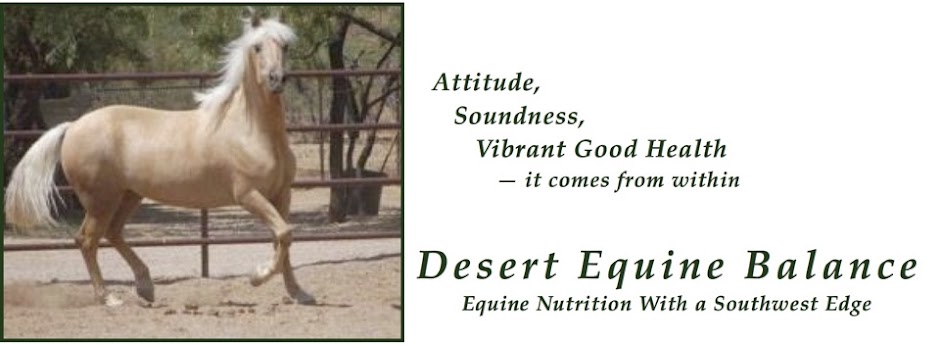Recently, I responded to a question on the EC list about one of the targeted "magic bullet" supplements that are becoming heavily marketed toward horses with laminitis. The supplement in question isn't a bad supplement - it is safe and would likely do the job - but in my mind it supplies some unnecessary nutrients, is overpriced and appeals to the emotional vulnerability of our desire to do the best we can for our horses.
The writer was appropriately seeking to support her horse's recovery from founder, but also wanted to know if the supplement would provide a "speedier" recovery.
There is no speedy recovery from laminitis/founder - under the best conditions, recovery is limited by the horse's ability to grow a new hoof capsule.
With all systems being optimal
- diagnosis by doing the correct blood work for metabolic issues to differentiate IR (insulin resistance or metabolic syndrome) from Cushing's Disease (PPID)
- appropriate medication only if definitively diagnosed with Cushing's
- removing the source or cause of the laminitis/founder
- diet based on low carbohydrate forage supplemented with minerals and vitamins that both provide recommended daily requirements and balance any excesses/deficiencies based on hay analysis or regional information
- frequent hoof care based on a trim which places P3 ground parallel and removes stress from the injured laminae
- non-weight bearing straight line exercise (no riding) as tolerated by the horse during recovery plus as much turn out as possible for free movement
recovery from laminitis/founder is going to take the time it takes to regrow a new hoof capsule with tight laminar connections - at least 8 to 10 months or more.
Even if your horse "appears" sound - if shod, with anti-inflammatory medication (bute or herbal), on soft resiliant footing or when wearing boots - it takes at least eight months for the hoof capsule to regrow and the damage to be repaired. Irregardless of which hoof care method you choose (I have personal preferences but my way is not the only way) it will take at least eight months before your horse can be safely started back in work.
Going back to work too early can stress the new growth and slow down the repair. Would you continue to jog, play tennis, go dancing before your broken foot healed? (I realize that some of us would but our horse does not have the option to choose.)
For a metabolically challenged horse, a half hour of grass or a scoop of the wrong feed at your boarding barn can put you back to step 1 and turn an eight month recovery into a year or longer. And trying to treat IR with medication instead of diet changes is an exercise in futility.
Good nutrition can help put your horse at the short end of the time line to regrow a new hoof capsule by providing the building blocks required for healing and repair. Your horse will need good quality low carbohydrate forage, quality protein, and minerals and vitamins that at least meet NRC requirements and balance the forage/hay. Healing requires higher levels of antioxidant support which can be safely enhanced by providing vitamin E at levels suggested by KER research and Omega-3 essential fatty acids from flax.
You don't need to spend $2 to $3 a day on a "magic bullet" supplement to supply what your horse needs. A custom mix that balances your hay analysis or regional needs will more likely be in the range of 60-90 cents a day with some locally purchased "add-ins" - vitamin E, magnesium, iodized salt - adding another 15-20 cents a day.
While many horses can benefit from anti-inflammatory herbs to improve comfort and/or nitric oxide donor herbs to improve circulation, these should be specific and targeted, not part of a "kitchen-sink" approach. Any herb at a level potent enough to provide benefit also has the potential for adverse side effects and their use should be carefully considered, along with the possibility of synergy (multiplication of individual actions when combined) and interaction with medications your vet may have ordered.
Once your horse is through the acute initial phase of a laminitis/founder attack, plan on hanging up your saddle for at least eight months and consider how to turn his recovery time into an opportunity. The additional TLC he will require almost guarantees a new bonding experience for you, a time when you can just be and reflect with your horse. Take the time to explore some of the excellent groups and websites focused on laminitis/founder and metabolics (see my links for a sampling). Learn what your horse's nutritional requirements really are, how to read labels and how to separate myth and advertising from fact. Plan a gradual reconditioning program so that once he can carry a rider again, he can do it safely with less chance of reinjury.
Speedy recovery? Don't expect it. But you can make this recovery time count toward your horse's long term soundness and health.


 There is a great temptation to buy Sudan grass hay as it is CHEAP - it can be found in areas around Arizona for about $6/bale and Bermuda and alfalfa are expensive! I, personally, do not feed Sudan grass hay (also known as Love grass, Johnson grass, Sorghum/Sudan hybrids) to my horses, or let them graze on these grasses.
There is a great temptation to buy Sudan grass hay as it is CHEAP - it can be found in areas around Arizona for about $6/bale and Bermuda and alfalfa are expensive! I, personally, do not feed Sudan grass hay (also known as Love grass, Johnson grass, Sorghum/Sudan hybrids) to my horses, or let them graze on these grasses.

